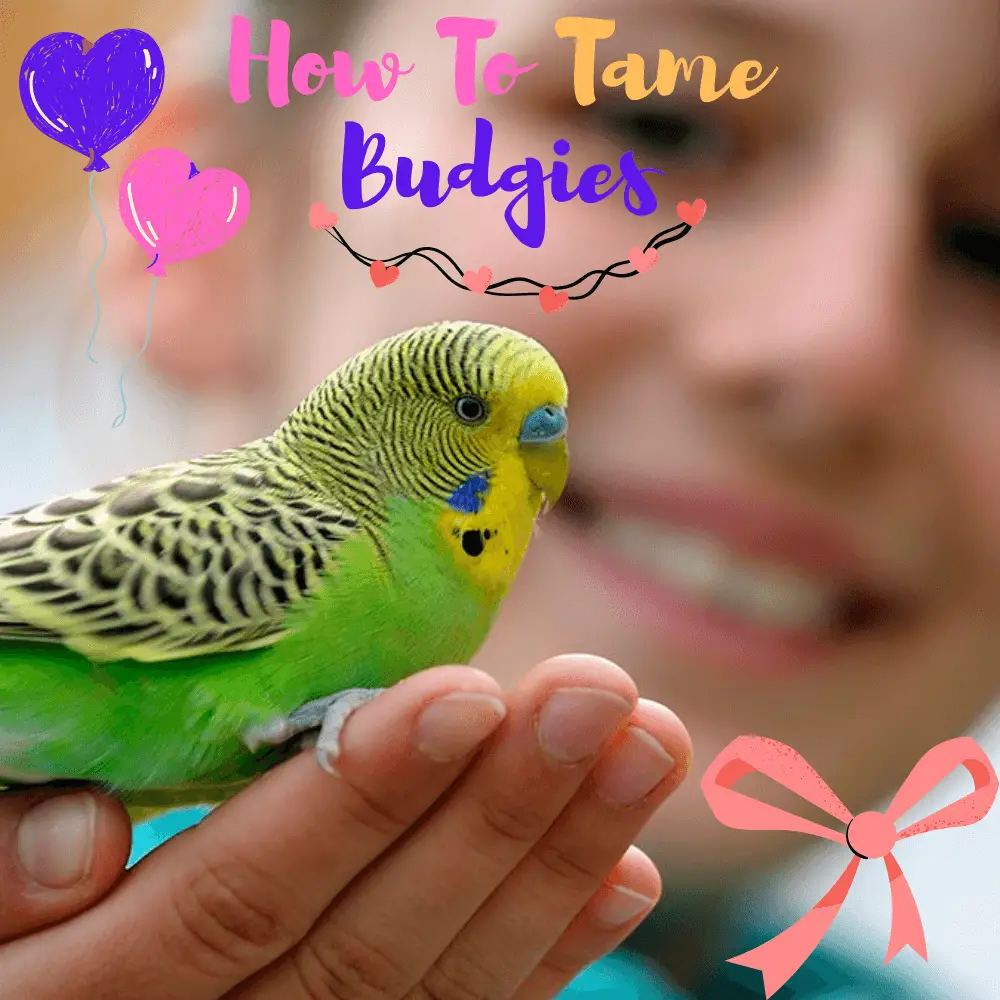
How to tame budgies? How to tame parakeets? Parakeets are very fun pet birds. Although they are not difficult to tame, this process requires a lot of time, patience, and consistency. Especially if the birds were not bred by hand and tamed at the same time. Having a group of several birds is essential, in addition, it facilitates taming since the boldest will help the most worried to get closer. Don’t forget to have fun taming your budgie. This can be a very rewarding experience for both you and her!
Gaining the trust of a budgie
All you need to know about gaining budgie trust
Let the budgie adapt to its environment
A budgie can be a rather febrile and fearful animal. It will not be very effective to want to tame a budgie if its environment makes it nervous.
- Let your budgie get used to its new surroundings for about two weeks if you just bought it. This will give him time to find the food and the water tank in his cage.
If possible, place the budgie in a fairly lively room during its adaptation period. It may seem paradoxical, but keeping her in a busy room will get her used to seeing humans as companions and not as a threat. You should know, however, that a budgie has sensitive hearing, so you should place it in a place that is not too stressful. Even if there are lots of things to see, you should be careful not to choose a room that is too noisy with music that is too loud or a room that has drafts because of the incessant back and forth. The environment should be pleasant and not disturb the bird.
Put the budgie’s cage close to you during your usual activities
Your budgie will need to be comfortable in your presence if you want to gain his trust. Give him about a week for that.
- Put the cage near you when you have a relaxing activity such as watching TV or reading.
- You do not need to interact directly with the bird when its cage is near you. It is more important that the budgie is comfortable in your presence.
Get in touch with your budgie without touching it
When the bird is comfortable with you, you can start exchanging with it more often. You should still be very patient with him so as not to increase his anxiety.
- Know that you should not exchange glances with your budgie. The eyes of budgies are located on the sides of the head, which is common in animals that are prey. Since humans’ eyes are in front of the head, looking directly at the budgie makes it understand that you are a predator and you certainly wouldn’t want it to see you that way.
Put your hand outside the cage and talk to the budgie in a soothing tone
Do not put your hand inside the cage
Gently open the door of the cage in order to get the bird out without putting its hand so as not to frighten the budgie. Do not try to touch it or anything in the cage. The goal is to get her out so that she can have “escape possibilities” in your presence. A bird that does not feel cornered by the gates of its cage will be more inclined to come to the hand of its owner.
- You can cover your hand with a towel if you’re worried about the budgie biting you.
Put your hand in the cage holding a treat like millet
Slowly move your hand closer to the budgie and see if it approaches you to grab the treat. Don’t be surprised or discouraged if the bird gets scared, petrified, or flies to another corner of the cage.
- Practice doing this at least three to five times. Bring your hand closer to the budgie during each session. She will eventually be more comfortable, approach you, and take the treat in your hand.
- Your budgie will be more comfortable with your hand if you present him with a treat every time you reach his cage to change his food and water.
- This step can take between several days and several weeks.
Taming a budgie with your hand
All about Parrot taming a budgie
Put your hand in the budgie’s cage
Use the same slow, firm gestures and calm voice used to put the bird at ease. Although at this point your budgie should be more comfortable with you and your hand, you should continue not to be a threat to it in order to make progress in taming it.
- Slowly stretch your index finger as a perch on which the budgie can climb.
- Cover your hand with a towel if you think the budgie will bite you.
Bring your index finger closer to the budgie
Be sure to go slowly. The budgie may react in the same way as when you brought your hand close to give it a treat. Wait until the budgie has calmed down if this happens, and then try again.
- You may have to try again later or try again another day if your budgie seems to be too scared and nervous.
Encourage your budgie to jump on your finger
When the bird is comfortable with your finger near it, gently rest your index finger on its chest and push it gently. Use very light pressure when you put your finger on his chest.
- The budgie can become nervous and move away from you if you press too her chest.
- Your budgie may not understand this movement at first and may fly away. Just be patient with her and try again until she understands what you want her to do.
- Saying ‘ride’ as a verbal cue to accompany your pressure on the budgie’s chest can help her understand that she should perch on your finger.
- You can use a little millet to encourage the budgie to climb on your finger if it hesitates.
Do not move your hand
Keep your hand as still as possible when your budgie climbs on your finger. Even though budgies are used to perches, yours may take a while to get comfortable with your hand as a perch.
- Reward her with a treat to encourage her to use your finger as a perch.
- Train the budgie several times a day to use your finger to perch on it and reward it each time.
Take the budgie out of the cage
When the budgie is comfortable riding on your finger, it’s time to teach her how to get out of her cage. Use slow movements and a soothing voice to pull him out of the cage.
- Your budgie may be very reluctant to leave her cage because she feels safe there. You can try to lure her in with treats, but don’t push her around.
- You will be able to remove your hand from the cage more easily by creating a clear exit route (without toys, food, or water tanks).
- It doesn’t matter if the budgie flies away or immediately returns to its cage when you have managed to get it out.
- Do not chase the budgie or chase it if it has flown away. This will give him the impression of being in a relationship of prey in front of a predator. Wait until she has landed somewhere and then approach her calmly. Reach out your hand so it can rise on your finger.
- Let the budgie relax a little and try again another time if it returns to its cage on its own.
- It will take at least a week of daily training to be able to get the budgie out of the cage and keep it on your finger, but it may take longer. Be patient and move at a pace that makes her feel comfortable or accustomed to being outside her cage.
Go with the budgie perched on your finger in different rooms
When your budgie is comfortable on your finger outside her cage, you can take her to rooms she doesn’t know. Parakeet owners often take their birds to the bathroom.
- It can be helpful to cover mirrors and pull curtains, as this can distract the bird, no matter what room you take it to. Also, make sure the room is clean and free of hazards such as a fan or other pets.
- Your budgie can fly away because it’s a new environment. Again, you shouldn’t chase her if she does.
- Offering the budgie a treat every time you change rooms can make her feel more comfortable with these new places. Expect to take the budgie for 15 to 20 minutes each time, several times a day.
Teaching a budgie to jump out
Pop the budgie off your index finger
Settle into a chair, on the floor, or on a bed
Put the index finger of the other hand on the chest of the budgie
Gently squeeze his chest as you did at first to teach him to perch on your finger. Gently push his chest when you tell him to jump.
- Your budgie may not understand this verbal cue, so you should try several times before she understands that she needs to jump off your index finger.
- Give her a small treat every time she jumps out of her finger.
Practice until she can jump on your other index finger without you needing to push on her chest.
Advice
- Don’t give up! It takes a lot of patience to tame a budgie, but it ends up being very rewarding.
- Stay calm and relaxed throughout the taming process. Keeping calm will make the budgie more comfortable when you work with it, even if it takes several months to tame it.
- It is easier to teach something to a young budgie than to an older bird. All kinds of animals can be tamed when they are young.
- Do not remove your hand when the budgie has bitten you. This will teach her to bite every time she wants to see you back off. This is a sign that your budgie is trying to educate you and not the other way around.
- Make sure you have closed all doors and windows when you take the budgie out of its cage, otherwise it could fly out the window!
- Millet seeds are high in fat, so they should be the only treat to offer your budgie. Other healthy treats are fresh fruits and vegetables, seeds, and pellets. Millet is, however, the most effective treatment for your budgie.
Warnings
- Some foods, such as apple seeds, avocados, chocolate, and onions, are toxic to budgies. Do not give them to your bird.
How to Tame a Budgie fast
SOURCE:Alen AxP




















